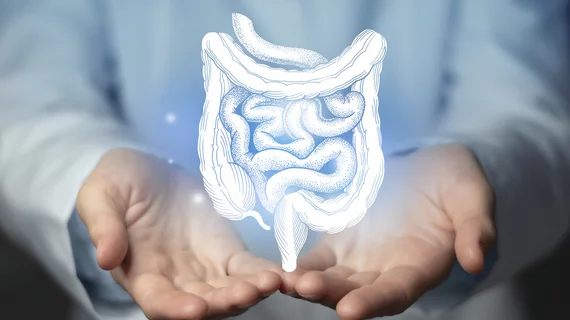AI spots missed colorectal cancers on routine CT scans
Artificial intelligence could improve the detection of colorectal cancer on routine abdominopelvic CT scans, according to new research.
Rates of colorectal cancer (CRC) are on the rise, most notably in younger adults, who have seen CRC diagnoses double over the last decade. A myriad of diagnostic exams, including colonoscopy, blood and stool tests and, in recent years, CT scans, are used to diagnose CRC.
While CT of the abdomen and pelvis provide patients with a noninvasive alternative to colonoscopy, the exams are not yet widely utilized for the purpose of spotting CRC. This could help to explain why radiologists are prone to missing some CRCs on routine abdominal CT scans. Experts involved in a new study believe artificial intelligence can help close this detection gap.
The team developed an AI model capable of spotting CRC on routine abdominopelvic CT examinations, performed without bowel preparation. This involved a dataset of nearly 4,000 patients, including a training set of 2,662 individuals with confirmed CRC who underwent routine contrast-enhanced abdominopelvic CT before treatment, plus additional internal and external test sets of people who underwent CT for any indication and a colonoscopy within a two-month interval.
Using the patients’ radiology reports, a radiologist identified all cases of CRC that were visible on CT and placed bounding boxes around the lesions on all slices showing cancer. This was used as the reference standard for determining the model’s performance for automated detection of CT-visible CRC on unprocessed DICOM slices.
The model performed well, achieving an AUC of 0.86 and 0.80, sensitivity of 79.6% and 80.8% and specificity of 91.2% and 90.9% on the internal and external test sets. In terms of its sensitivity, the AI either outperformed or achieved the same level of accuracy as two trained radiologists on the external test set. For specificity, the model’s performance came in slightly lower than the radiologists, but only by five percentage points. What’s more, the model also identified five out of nine CRCs missed on initial interpretation.
The team suggested their model could improve detection rates of CRC on routine exams, even in patients who are seen for reasons other than suspicion of cancer.
“Radiologists are prone to missing some CRCs on routine abdominopelvic CT examinations that are in fact detectable on the images,” Joon Seok Lim, MD, PhD, with the Research Institute of Radiological Science at Severance Hospital in the Republic of Korea, and colleagues noted. “The AI model could help reduce the frequency of missed CRCs on routine examinations performed for reasons unrelated to CRC detection.”
Learn more about the findings here.

